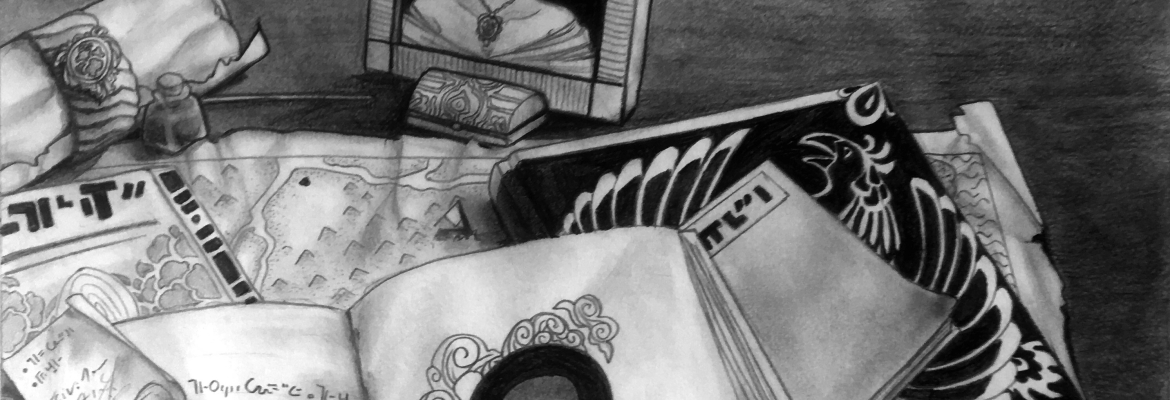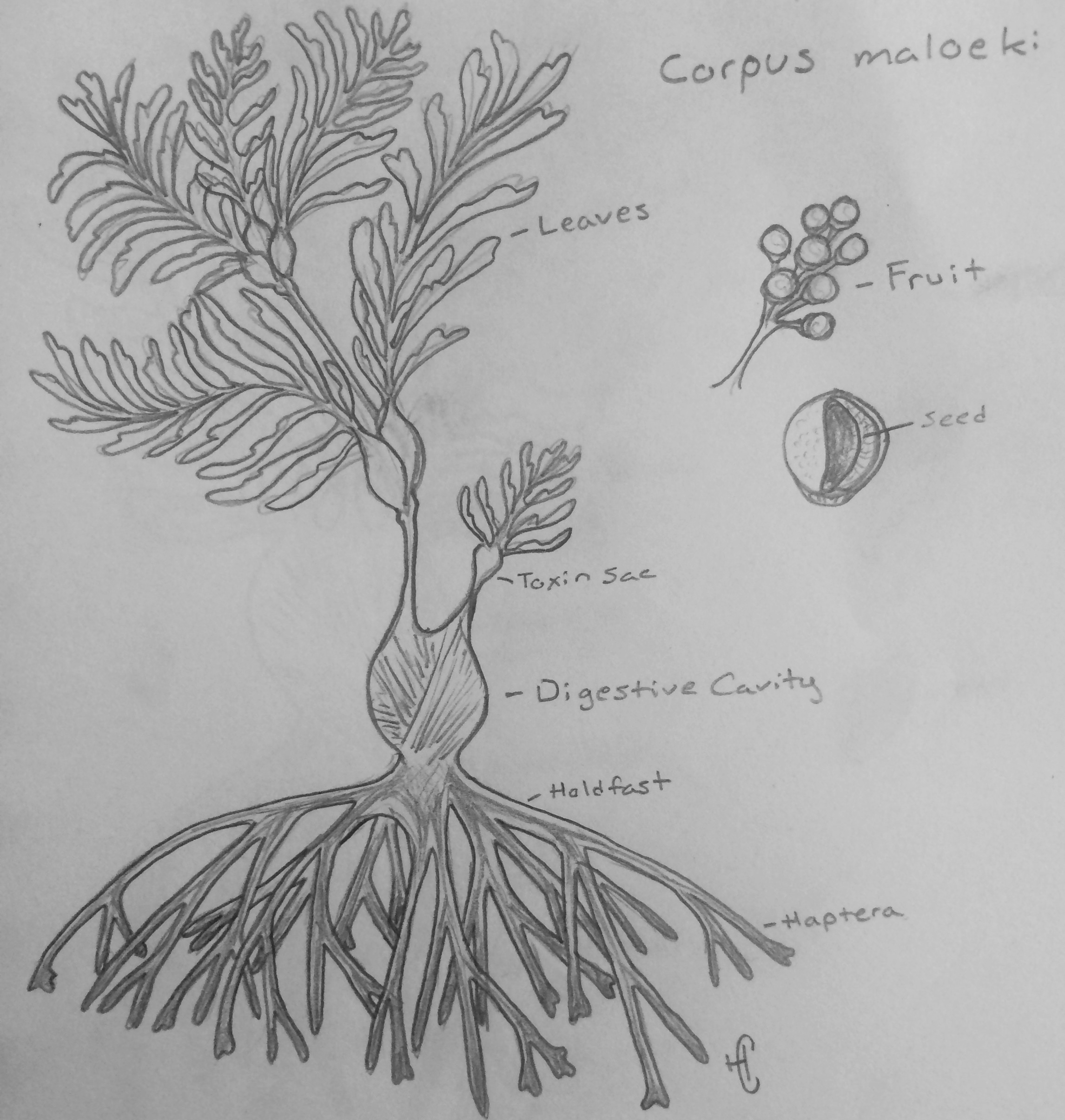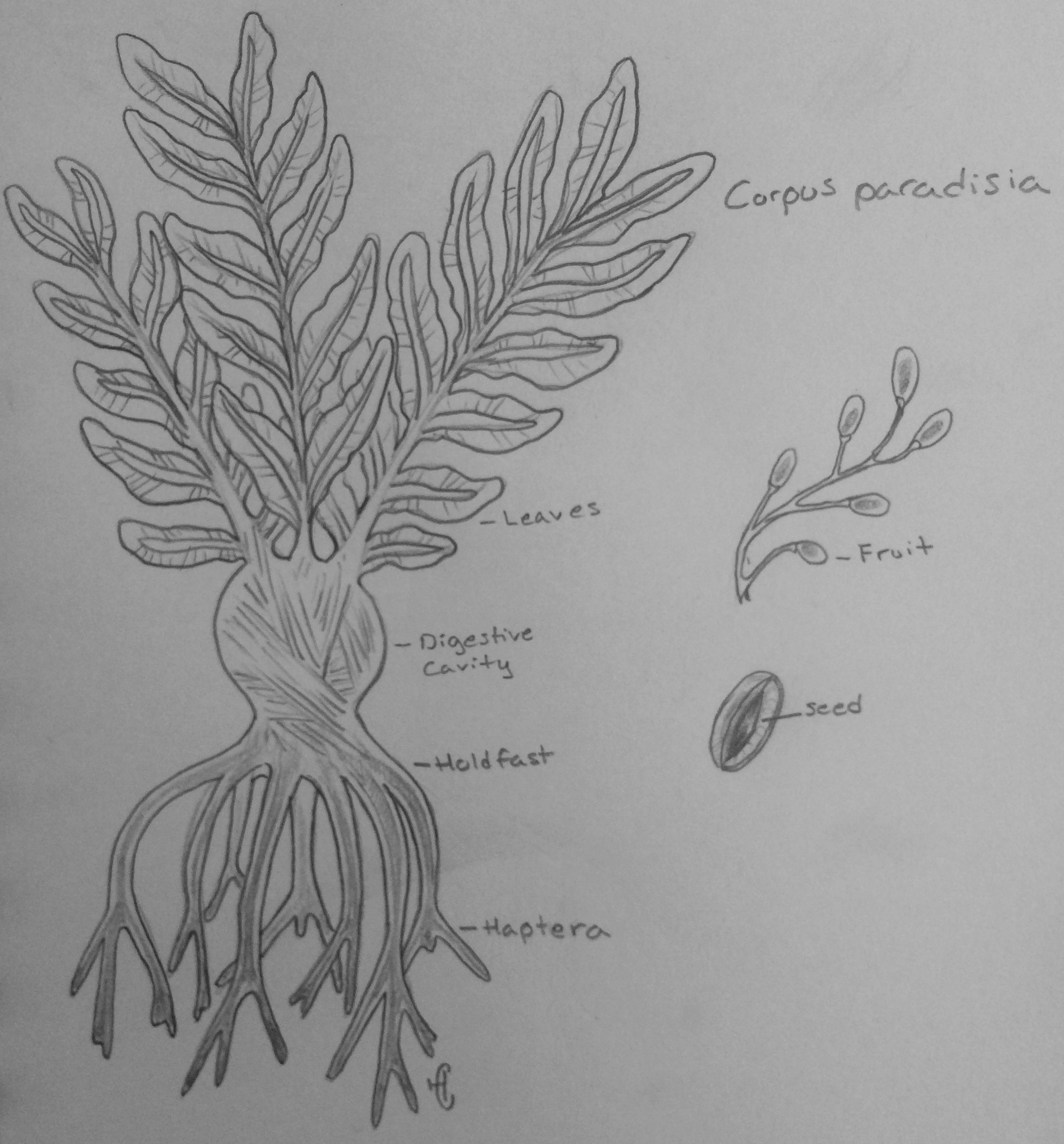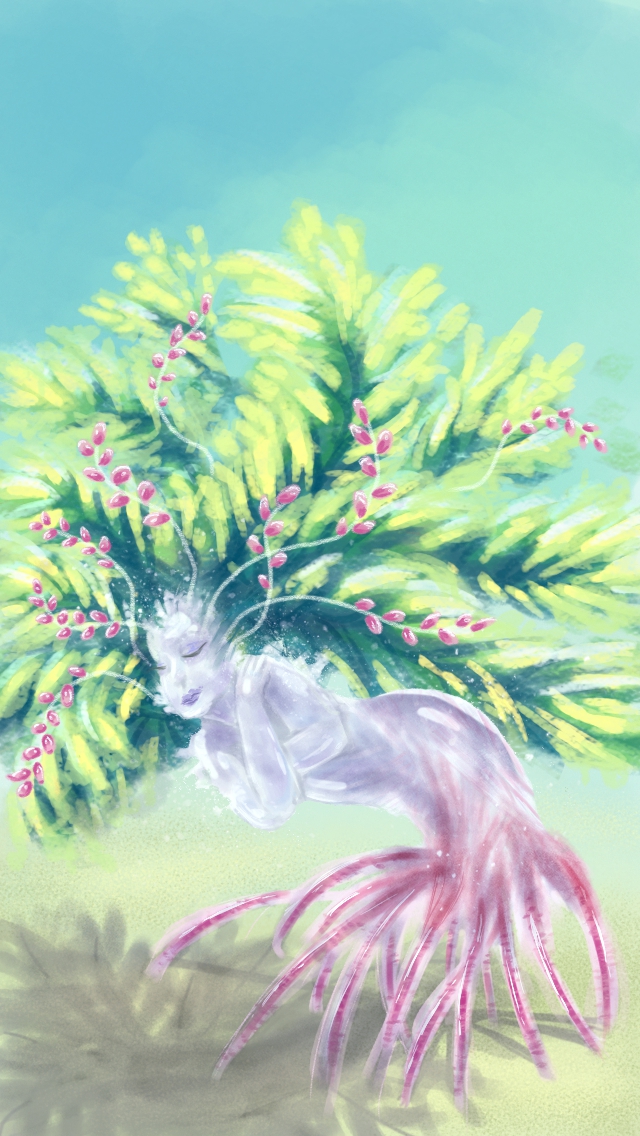Corpse Kelps are three species of plants in the genus Corpus, named after the way they grow on corpses, breaking them down for nutrients until they mature and are able to support themselves. The name is misnomer as the Corpse Kelps are not kelp but carnivorous, fruiting plants that share a similar appearance and structure to kelp. They one of a few types of marine plants that do not have a true root system but instead a holdfast similar to algae.
They form underwater forests in shallow, tropical waters and can spread very quickly. The island of Maloeku which was faced with an epidemic of Corpus maloeki, however, they were able to keep it under control and the ring of Corpse Kelp surrounding the island now serves as a strong natural defense.
Description
Corpus maloeki
Diagram of a young Corpus maloeki and its fruits and seeds.
The maloeki have dark green, feathered decompound leaves branching off of a thin petiole. Where the petiole connects to the stem, there is a sac which contains toxins that are released when the plant is threatened. When one plant releases these toxins, the other nearby maloekia will do the same. The toxins that are released are neuromuscular blockers which cause paralysis of skeletal muscles. Though the toxins in the maloeki are weaker than those in the paradisia, they can be dangerous if released in a forest of Corpus maloeki.
The haptera of the plant's holdfast are wiry and thin with a brown coloration. They are covered in a thin, clear layer of slime that contains the same toxins that are released by its leaves. Because it grows mainly in coral reefs and loose sand, the haptera begin branching laterally early on in order to cover more surface area and better hold the plant down.
The fruits of the maloeki are pale yellow spheres that grow in clusters close to the leaves. Ingesting the fruit is deadly as it contains traces toxins absorbed from the plant's prey. It is usually the case that the older the plant, the more deadly its fruit is. The fruit from young and cultivated Corpus maloeki are considered a delicacy but are hard to come by and quite expensive due to the risk.
Corpus paradisia
Diagram of a young Corpus paradisia and its fruits and seeds.
The leaves of the paradisia are wide and linear in shape, arranged in an even-pinnate on the stem. Ruffling occurs on the sides of the wide midrib. They are vivid green in color and show a bright yellow-green when the sun shines through.
The holdfast is magenta in color with a thick, pale slime coating the haptera, containing a strong, fast-acting, neuromuscular blocking toxin that causes full body paralysis when touched and may cause death if ingested. The haptera act like prop roots, holding the plant above the sea floor, only branching ten inches beneath the seafloor.
The fruits of the paradisia are oval in shape, resembling a grape, and have a vivid magenta color. They are arranged alternately on the stem.The fruit's hallucinogenic properties give the species its name and they can be found sold in the black market along with their derivatives under the name "Paradise".
Corpus excoralgia
Corpus Excoralgia is a mythical existence. The only recorded sightings of it are in ancient tablets and a few explorers’ journals. Experts doubt if it actually exists or if it has just gone extinct.
According to recorded sightings, excoralgia can be found on the body of the Četnamoré, an enormous sea serpent that circles the oceans of the world. The plant is said to have dark, round, blue-green leaves and a pitch black holdfast that stretches out across the debris on the serpent’s body, intertwining with the roots of other excoralgia and creating a vast net.
It is rumored to be extremely poisonous, with one tale accounting that an entire exploration party of
Deljudi were killed before it eventually consumed their entire tribe.
When parts of the Četnamoré surface, researchers and historians flock to the area in hopes of finding some traces of the plant but there has been no luck yet.
Geographic Distribution
Corpus maloeki forests can be found circling Maloeku and in a few areas Southeast of the island while Corpus paradisia can only be found close to the islands of Itzioa and its coastline.
The Corpus excoralgia is said to grow on the body of the Četnamoré but this has not been confirmed.
Growth and Reproduction
The actual mechanisms by which Corpse Kelps reproduce is unknown. The plants produce fertilized seeds surrounded by a fleshy fruit however the means of fertilization eludes researchers. No flowers have ever been sighted on a Corpse Kelp nor any clues that might point researchers in the right direction. What they have noticed, however, are the interesting steps that lead up to the seed's germination.
The brightly colored fruits produced by the Corpus maloeki and paradisia release a chemical that attracts nearby animals. Only a few species of fish have developed a resistance to the toxins of the plant and are able to eat the fruit.
The toxins within the fruit slowly kill the fish while the hard to digest seed slowly germinates. The fish becomes what is known as ‘seeding prey’ giving the new plant the nutrients it needs to grow. The plant produces a slime that coats the seeding prey, preserving the body and preventing it from being eaten. Eventually, a shoot will pierce its way out of the corpse of the seeding prey, growing towards the light while the holdfast grows away from the light.
A slimy membrane will form another layer surrounding the prey, creating the plant’s digestive cavity located between the holdfast and the stem. The plant will eventually completely dissolve the seeding prey and absorb the nutrients.
If an animal that has not developed a resistance to the plant’s toxins eats the fruit it will die too quickly and without the slime coating the corpse will rot. This prevents the plant from germinating as it cannot get the required nutrients on its own.
Feeding Behavior
The Corpse Kelps are a carnivorous plant that feed on any animal that it catches. The toxins released by the plant paralyze nearby animals and may kill them if ingested. If the prey is close enough, the slimy membrane of the digestive cavity will reach out to drag the prey within. If the digestive cavity is not big enough to hold it, it will grow out, around the prey. This results in varying sizes of digestive cavities among different plants.
Acids within the digestive cavity dissolve prey and the plant absorbs their nutrients. Because the Corpse Kelps do not have true roots, they require nutrients from an external source to thrive. If there is a lull in prey, they can rely on photosynthesis to live though their slime production will slow.
The Graveyard Crisis
In 1027 S.D. a Deljudi tending to the Maloekian
Coral Graveyard discovered a plant growing out of a recently buried body. He cut it at the base and reported it, but within a few months, all of the recent burials had been taken over by the plant. A Čoljudi youth paying her respects to a family member’s grave was found dead one morning. She had been paralyzed by the surrounding Corpse Kelps and drowned, unable to swim to the surface for more air.
That incident got people moving to find a way to fix the problem. Experts relied on Deljudi tribesmen to bring back samples of the plants that they cut down for studying. No one could find a surefire way to get rid of the plants and each time one was not completely uprooted, it would grow back again.
Through careful observation, it was found that the seeds of the plant required other animals to germinate. Burials for the deceased were halted, the fruits of the plants were collected when spotted and Deljudi tribesmen patrolled the surrounding waters collecting any dead fish or animals affected by the plant’s toxins.
Eventually, the spread of the plants fell stagnant and the existing plants were slowly removed. Many bodies from recent burials had been dissolved and absorbed by the plants and a memorial was set up for them amongst the corals to compensate.
Barrier Forests
After the Graveyard Crisis, some argued that the Corpus maloeki should not be completely removed from the area. They pointed out that the paralytic toxins of the plant were strong enough to keep people away and that when they formed large forests they could even keep large sea creatures away. And indeed it was true. During the Graveyard Crisis, the amount of large sea creatures spotted around the island had decreased.
Botanists also advocated keeping the plants around. While researching how to get rid of the plants and how to resist their toxins, they found that the toxins of the plant could be diluted and made into medicines to relieve muscle pains and numb injuries. One botanist who had been studying the leaves of the plant said that there was a good possibility that the plant had the same Alginic acid that can be found in brown kelp.
Convinced, Emaniya, the Queen of Maloeku, decided that the Corpse Kelp would be allowed to grow in a ring around the island. She asked if the Deljudi tribes would help in keeping the plants from spreading as they had a natural resistance to the plant’s topical toxins. The Deljudi agreed and thus what is now known as the Barrier Forest was created.
The Barrier Forest keeps large carnivorous sea creatures away, allowing the fish living around the island to thrive. The amount of fish that fisherman were allowed to catch around the island increased to compensate for the lack of predators that the fish had and to preserve the ecosystem. Additionally, the fish farming industry no longer had to worry about the large sea creatures breaking in and eating all their stock as they had done many a time before.
Uses
Commercial
Alginic acid extracted from the leaves and slime coating of the Corpus maloeki is used as a thickening and gelling agents in foods, waterproofing and fireproofing textiles, reactive dye printing, and pharmaceuticals.
Njirralde is a major importer of the algenic acid which they use in a variety of their world famous jelly confectionery.
Medicinal
Toxins from the fruit, leaves, and slime coating of both the Corpus maloeki and Corpus paradisia are incorporated in a variety of medical concoctions which range from topical anesthesia and analgesics to treatment for muscular injuries depending on the concentration of the toxins.
These treatments are very popular in and around Maloeku and Itzioa where the species grow and efforts to cultivate the plants have made them cheaper and more available to others around the world.
Defense
The ring of Corpus maloeki around Maloeku acts as a defensive barrier protecting the coral reefs, fish, and Deljudi tribes that live in the surrounding waters from large, carnivorous sea creatures. The Deljudi tribes which have a resistance to the topical paralytic toxins of the plants work to maintain the barrier forest and prevent them from expanding.
Some have tried to mimic this in Itzioa but there has been little success due to the increased toxicity of the Corpus maloeki.






Comments